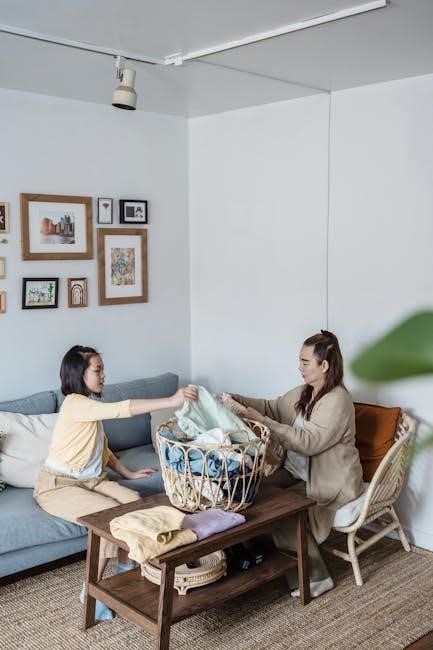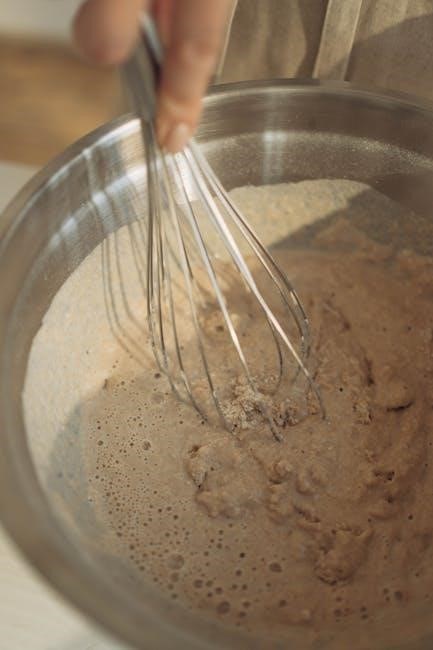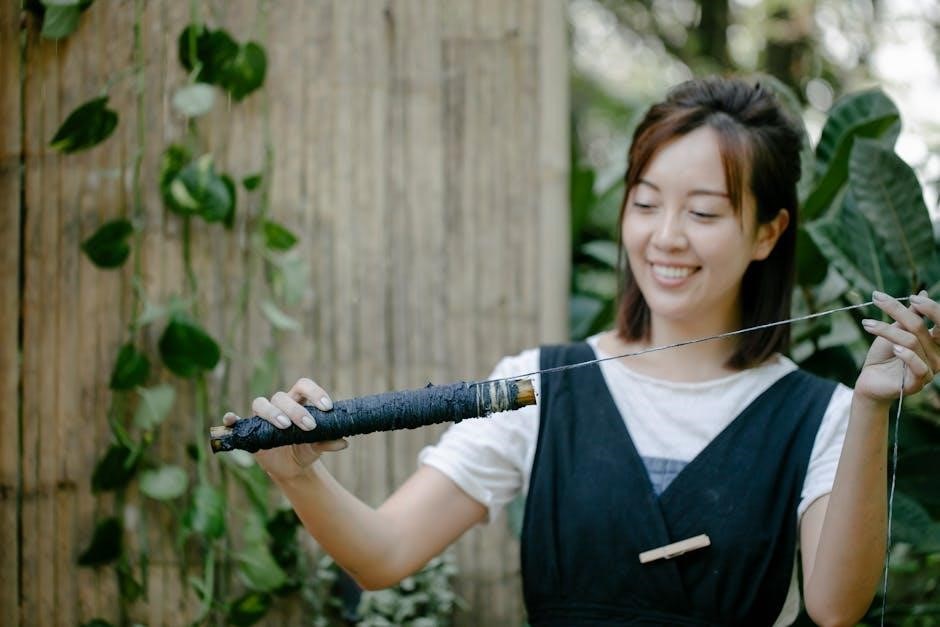tie dye folding techniques with pictures pdf
Discover the vibrant world of tie-dye folding techniques, an artistic way to create unique fabric patterns. From spiral to bullseye folds, these methods offer endless creativity in transforming fabric into colorful designs.

Materials Needed for Tie-Dye Projects
To embark on a tie-dye project, you’ll need several essential materials. Start with natural fabrics like cotton, linen, or rayon, as they absorb dye effectively. Fiber-reactive dyes are ideal for vibrant results. Rubber bands are crucial for creating folds and resistance areas. Protect yourself with gloves and old clothing, and cover your workspace with a plastic tablecloth. Measuring cups and spoons are necessary for accurate dye mixing. Soda ash is used to pre-treat fabrics, enhancing dye absorption. Squeeze bottles can help apply dye precisely, while buckets or containers are needed for mixing and dyeing. Access to running water is essential for rinsing, and a washing machine may be required for the final wash. Having these materials ready ensures a successful and enjoyable tie-dye experience.

Essential Tie-Dye Folding Techniques
Mastering essential tie-dye folding techniques is key to creating unique patterns. From spiral to bullseye folds, these methods transform fabric into vibrant designs, perfect for beginners and crafty enthusiasts alike.
Spiral Fold Technique
The spiral fold technique is a popular method in tie-dye that creates a vibrant, swirly pattern. Start by laying the fabric flat and pinch the center. Twist the fabric outward in a circular motion until it forms a spiral shape. Secure the edges with rubber bands to hold the fold in place. This technique allows the dye to penetrate unevenly, resulting in a unique, eye-catching design. It’s perfect for creating bold, colorful spirals that stand out. The spiral fold is a great starting point for beginners, as it’s easy to master and delivers stunning results. Experiment with different folding tightness and dye colors to achieve varied effects. This method is ideal for crafting one-of-a-kind shirts, scarves, or any fabric item. With the spiral fold, you can create a beautiful, handcrafted piece that showcases your creativity and skill in tie-dye art.
Bullseye (Circle) Fold Technique
The bullseye, or circle fold, is a classic tie-dye technique that produces concentric circular patterns. Begin by pinching the center of the fabric and gathering it into a small bunch. Fold the fabric outward in layers, creating multiple circles. Use rubber bands to secure each layer, ensuring tight folds for crisp dye lines. This method allows for precise control over the pattern, resulting in a clean, symmetrical design. The bullseye fold is versatile and works well for various fabric types. It’s ideal for creating focal points on shirts, dresses, or scarves. By adjusting the number of folds and the tightness of the rubber bands, you can achieve different sizes and colors in the bullseye pattern. This technique is a must-try for both beginners and experienced tie-dye enthusiasts looking to add a touch of elegance to their projects. The bullseye fold is a timeless choice for creating stunning, professional-looking designs.
Crumple (Random) Fold Technique
The crumple, or random fold, is a simple yet dynamic tie-dye technique that creates unique, organic patterns. Start by laying the fabric flat and scrunching it into a loose, irregular shape. Gather the fabric into a small bunch, ensuring no specific alignment. Secure with rubber bands to form a compact, textured bundle. This method allows the dye to penetrate unevenly, resulting in a one-of-a-kind, abstract design. The crumple fold is perfect for achieving a laid-back, bohemian look. It’s great for beginners, as it requires minimal folding precision. Experiment with different levels of crumpling to vary the intensity of the pattern. Tighter folds create more defined textures, while looser folds allow for softer color blending. This technique is ideal for crafting casual, eye-catching pieces like scarves or t-shirts. Embrace the unpredictability of the crumple fold to add a touch of spontaneity to your tie-dye projects. The result is always unique and visually striking, making it a favorite among tie-dye enthusiasts.
Striped Fold Technique
The striped fold technique is a popular method for creating straight, parallel lines in tie-dye. To achieve this, lay the fabric flat and fold it into accordion-style pleats, ensuring each fold is aligned and evenly spaced. Once folded, secure the fabric with rubber bands to maintain the structure. The number of folds will determine the width of the stripes, with more folds resulting in narrower stripes. For a classic look, fold the fabric horizontally or vertically, depending on the desired stripe orientation. This technique is ideal for those who prefer a more organized and symmetrical pattern. The stripes can be dyed in a single color or multiple hues for a vibrant effect. The striped fold is a versatile method that works well for both beginners and experienced tie-dye enthusiasts, offering a clean and modern aesthetic to any fabric project.
Heart Fold Technique
The heart fold technique is a charming method to create a heart-shaped pattern on fabric. To achieve this, fold the fabric into a heart shape by bringing the top corners together and securing them with rubber bands. This technique allows the dye to form a central heart design with unique, organic patterns radiating outward. The heart fold is perfect for creating symbolic and visually appealing tie-dye designs. It works well for both small and large fabrics, making it ideal for shirts, dresses, or scarves. The folds can be adjusted to vary the size and complexity of the heart shape. This method is popular for its sentimental appeal and is often used for personalized or themed tie-dye projects. With proper folding and dyeing, the heart fold technique can yield stunning, one-of-a-kind designs that stand out.
Mandala Fold Technique
The Mandala fold technique is a popular method for creating intricate, symmetrical patterns on fabric. This technique involves folding the fabric into concentric circles or squares to form a mandala design. To achieve this, the fabric is typically folded into layers, with each layer creating a new level of symmetry. Rubber bands or ties are then used to secure the folds, ensuring that the dye penetrates evenly and creates the desired pattern. The Mandala fold is ideal for those who enjoy geometric and meditative designs. It works well with natural dyes and can be customized to suit various fabric types. The result is a visually striking pattern that resembles traditional mandala art. This technique is perfect for creating unique and meaningful tie-dye designs, making it a favorite among crafters and artists alike.

Advanced Tie-Dye Folding Techniques
Explore advanced methods like shibori and marbling, offering intricate, artistic patterns. These techniques require precision and creativity, perfect for crafters seeking complex, unique designs that elevate tie-dye artistry.

Shibori Folding Technique
Shibori is an advanced tie-dye method originating from Japan, known for its intricate, textured patterns. It involves folding, twisting, or pleating fabric and binding it tightly with threads or clips before dyeing. This technique creates unique, resist-dyed designs where the folded areas resist the dye, resulting in striking geometric or organic motifs.
To master Shibori, start by preparing your fabric, often dampened to ensure crisp folds. Popular folding methods include accordion pleats, twisted tubes, or intricate layering. Once folded, bind the fabric securely with thread or clips to prevent dye penetration. Dyeing can be done in multiple steps, allowing for layered color effects. After dyeing, carefully remove the bindings to reveal the hidden patterns. Shibori is both meditative and versatile, suitable for creating everything from subtle textures to bold, artistic designs. It’s a favorite among crafters and designers seeking to elevate tie-dye to a sophisticated level, often seen in high-end fashion and cultural textiles.
Marbling Folding Technique
The marbling folding technique is a unique and artistic method that creates fluid, water-inspired patterns on fabric. Unlike traditional tie-dye, marbling involves floating dye on water and manipulating the fabric to capture the colors in a dynamic way. This technique requires a container filled with water, dye, and a thickening agent to create a viscous surface. Fabric is then gently placed on the water, and tools like blowpipes or straws are used to direct the dye into swirling, marbled designs.
The process begins with preparing the fabric, often by soaking it in water to ensure it floats evenly. Once the dye is applied, the fabric is carefully folded or manipulated to capture the patterns. The result is a soft, organic design with blended colors that resemble the movement of water. Marbling is a versatile technique that works well for scarves, dresses, and other lightweight fabrics, offering a more fluid and unpredictable alternative to traditional folding methods.
